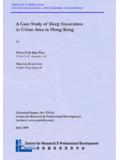Transcription of Technical Note TN-01 - crpd-hk.com
1 Introduction Although circular reinforced concrete ( ) sections are commonly used for foundations and columns, it is interesting to note that there is no guideline for design of shear reinforcement in the latest code of practice for reinforced concrete (BD, 2004) used in Hong Kong. This Technical Note aims to compare two design formulas available for design of shear reinforcement for circular sections. Rectangular section For a rectangular section, the commonly accepted formula for design of shear reinforcement is.
2 () 870 (1) where bv = breath of section, sv = spacing of links along the member v = design shear stress across the section vc = design concrete shear stress fyv = characteristic strength of links The factor represents the reciprocal of a material factor applied to the characteristic strength of steel reinforcement based on the 1985 version of the British Code BS8110. For more recent versions of BS8110, the design code becomes less conservative. A smaller material factor is allowed and hence the factor in is replaced by In Hong Kong, the code of practice for design of concrete is still largely based on the 1985 version of BS8110.
3 Therefore, we will retain the factor in the design equation of and other design formulas presented later in this Note. For a rectangular section, the effective area A is usually taken as A = bv d, where d is the effective depth of section. - 1 - Clarke & Birjandi s method Shear reinforcements for circular sections are commonly provided in the form of circular links. Clarke & Birjandi (1993) proposed a formula for design of circular links by modifying Before introducing this formula, the following concepts are discussed in Clarke & Birjandi (1993).
4 A. Effective depth, d Referring to Figure 1(a), the effective depth is defined as the distance from the extreme compression fibre to the centroid of the tension reinforcement in the opposite half of the member (Clarke & Birjandi, 1993). If the main reinforcement bars are closely spaced, the centroid C of the tension reinforcement can be approximated by the centroid of a semi- circular arc as shown in Figure 1(b). Using such an approximation, a closed-form, but approximate, solution can be developed for calculating the effective depth as follows: () sinrd+=1 (2) where rrsins 2= b.
5 Effective area, A For a circular section, the effective area can be taken as the area of shaded zone in Figure 1(a). If the effective depth is approximated by , the effective area of a circular section can be taken approximated as: ++= cossinrA 22 (3) The shear stress is calculated by dividing the shear force by the effective area. c. Effective breath, b Using and 3, the effective breath of a circular section is defined as: - 2 - rsincossindAb +++== 12 (4) The formula proposed by Clarke & Birjandi (1993) for a circular section is equivalent to replacing the width bv of a rectangular section in by the effective breath b of the circular section, viz.
6 () (5) is based on the material factor used in the 1985 version of BS8110. Feltham s method Feltham (2004) adopted the same concept of equivalent depth, equivalent area and equivalent breath of a circular section as Clarke & Birjandi (1993), but argued that one should consider the reduction in effectiveness of a circular link in resisting shear force due to its curvature of the shear reinforcement. For closely spaced main reinforcement and closely spaced circular links, Feltham (2004) developed the following closed-form, but approximate, formula for design for circular links.
7 () (6) where r = radius of circular section kc = a factor depending on the radius rs of the circle circumscribing the centre main reinforcement bars (see Figure 1). The factor varies over a narrow range close to It should be pointed out that there is typographic error in Feltham s paper. In of the main text of Feltham s paper, the parameter r is missed out. The correct formula presented in Appendix B of Feltham s paper contains the parameter r. is based on the material factor used in the current version of BS8110.
8 If one adopts the material factor based on the 1985 version of BS8110 ( replacing the factor of by ), replaces 2r by the diameter D of the circular section and takes the value of kc as unity for simplicity, is modified as: - 3 - () (7) Feltham s formula is equivalent to replacing bv in by the diameter of the circular section. The effective breath b of a circular section is always smaller than the diameter D, Feltham s formula requires a larger area of shear reinforcement to resist the same design shear force as compared with Clarke & Birjandi s formula.
9 Comparison of two formula If R is the ratio of required area of shear reinforcement based on Feltham s formula and that based on Clarke & Birjandi s formula, the value of R can be calculated using the formula derived from () cossinsinbDR +++==212 (8) Figure 2 shows the variation of R versus the ratio of rs/r. It can be observed that the Feltham s formula generally requires about 20% more area of shear reinforcement as compared with Clarke & Birjandi s formula. References Buildings Department (BD) (2004). Code of Practice for Structural Use of Concrete.
10 Clarke, and Birjandi, (2004). The behaviour of reinforced concrete circular sections in shear , The Structural Engineer, , , 73-81. Feltham, I. (2004). Shear in reinforced concrete piles and circular columns , The Structural Engineer, , , 27-31. - 4 - Figure 1 Effective area, width and depth of a circular reinforced concrete section Figure 2 R versus rs/r

